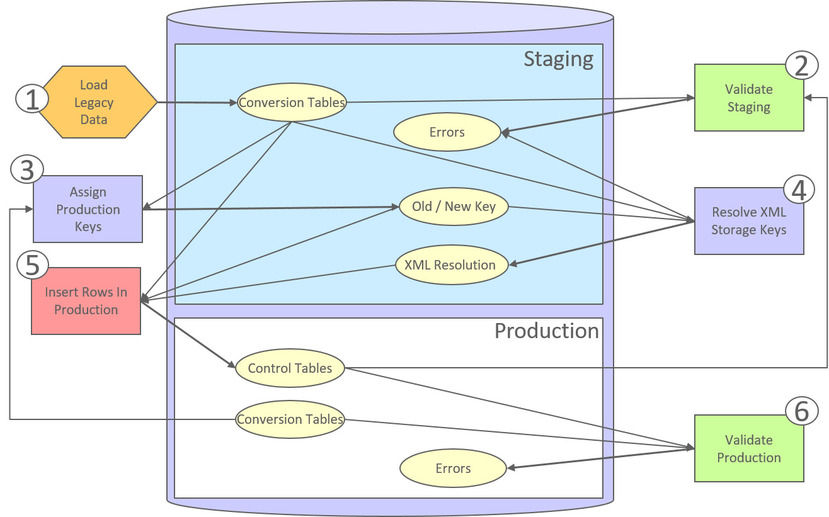Understanding The Conversion Process
When you're ready to convert data from your legacy system, you will have analyzed your processing requirements according to your business and organizational needs and set up the control tables accordingly. After the control tables are set up, you are ready to load data into the system from your legacy system.
There are two table owners in the system database. We refer to the first owner as staging and the second owner as production. The staging owner is linked to the tables into which you insert your pre-validated data. The production owner is linked to the tables used by your production system.
Note:
It's important to notice that control tables exist only in production. In staging, they exist as views to the production schema. Refer to Multiple Owners In A Single Database for more information about table ownership.
It's important to notice that control tables exist only in production. In staging, they exist as views to the production schema. Refer to Multiple Owners In A Single Database for more information about table ownership.
The conversion effort involves several steps as illustrated in the following diagram:

The following points briefly outline each of the above tasks:
• Load Legacy Data. During this step, your legacy data is loaded into the system. Notice that you are not migrating this data directly into production. Rather, your rows are loaded into tables that are identical to the production tables; they just have a different owner. Mapping legacy data into the system is probably the most challenging part of the conversion process because the system is a normalized database (and most legacy applications are not).
• Validate Staging. During this step, the system validates the data you loaded into the staging tables. Note that validation rules validate your staging data using the control tables that have been set up in production.
• Assign Production Keys. During this step, the system allocates random, clustered keys to the rows in the staging database.
• XML Resolution. During this step, the system resolves legacy keys that may be mapped to an XML storage field with new values that were assigned in the key assignment step.
• Insert Rows Into Production. During this step, the system populates your production tables with rows from the staging. When the rows are inserted, their prime keys and foreign keys are reassigned using the data populated in the key assignment and XML resolution steps.
• Validate Production. During this step, you rerun the object validation processes, but this time against production. We recommend performing this step to confirm that the insertion programs have executed successfully.
Note:
Additional steps may be needed to support specific data conversion requirements. Refer to your product’s documentation for additional conversion related information.
Additional steps may be needed to support specific data conversion requirements. Refer to your product’s documentation for additional conversion related information.
This section further discusses concepts and guidelines related to the conversion process.
Parent topic